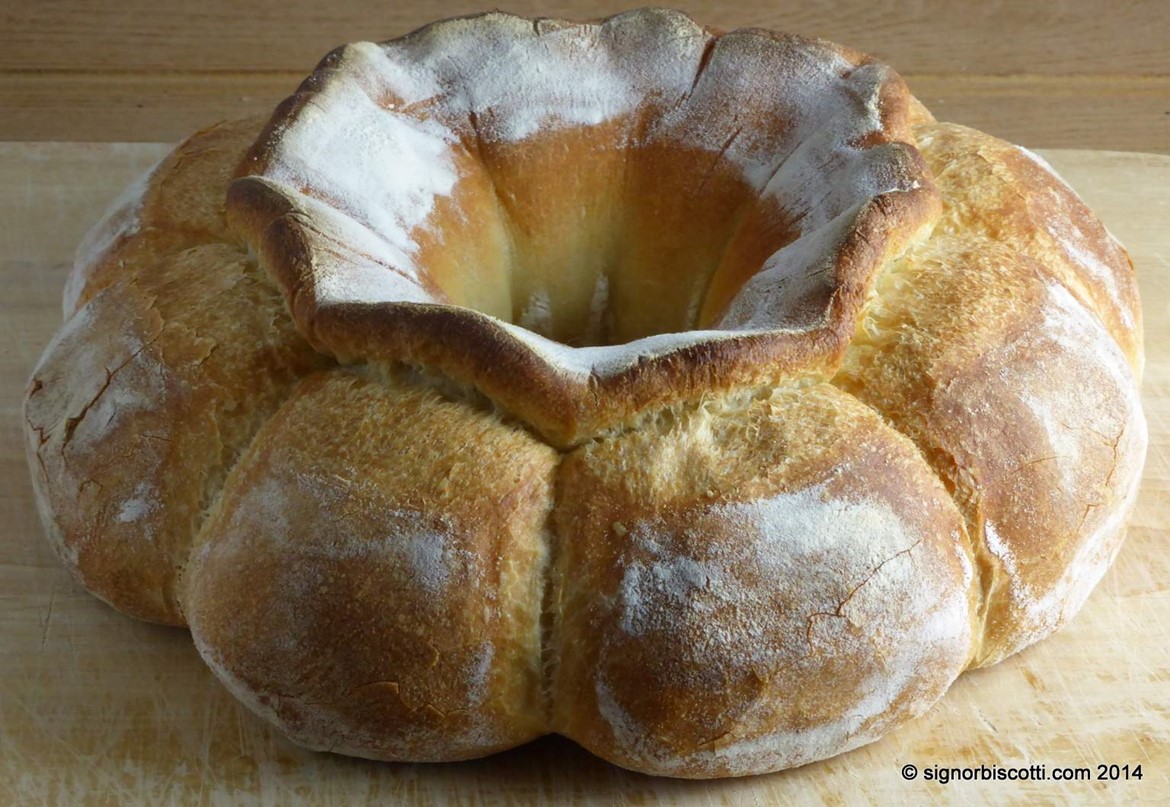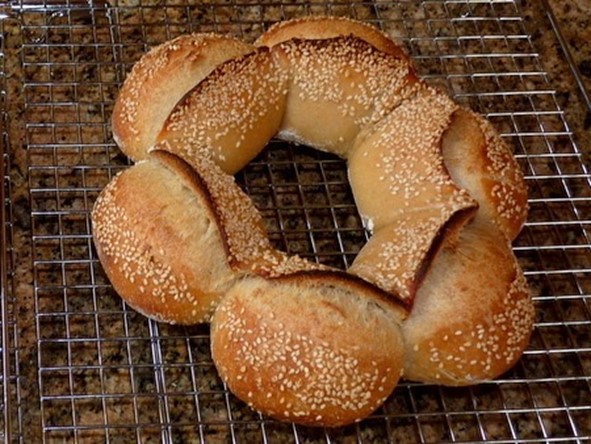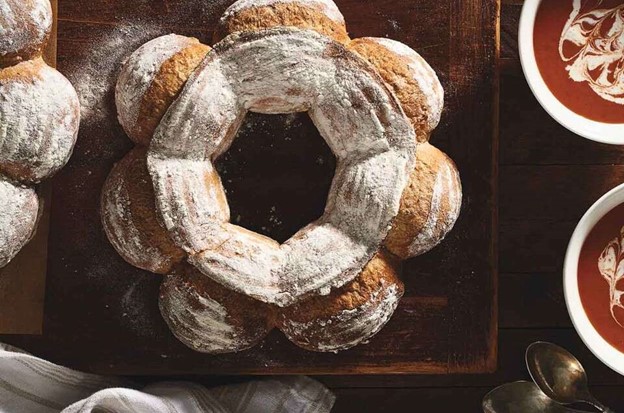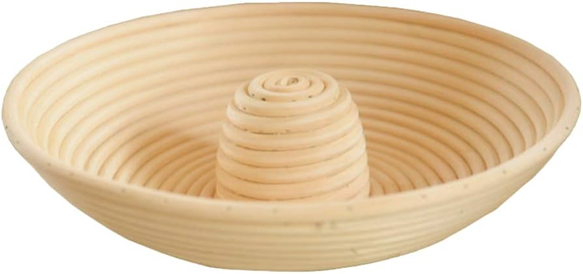Try the Couronne Shaping Method on Your Next Batch of Bread!
“Couronne” is French for “crown.” This bread shaping technique originated in France. It’s traditionally a ring-shaped loaf composed of six to eight balls of whole grain bread dough, blanketed by another flat disk of dough that holds the loaf together.

As the couronne bakes, the disk of dough rises away from the balls, making it seem as though the loaf was expertly scored rather than simply shaped. Though the technique may seem complex, a few simple photos and instructions is all you need to turning out a beautiful crown yourself.
While this process is a little time-consuming, the results are so pretty. It’s worth the practice to create something outside of the traditional 8 1/2″ x 4 1/2″ loaf pan.

Bread pros say you’ll want a recipe developed especially for this look. I found just the one on the King Arthur Flour site—their “No-Knead Multigrain Crown” recipe. Reviewers all say they really like the nutty wholesomeness of this loaf, although just about any no-added-fat bread recipe will work.
Whatever recipe you use, you’ll want to prepare your dough the night before you want to bake. You’ll need a large, 6-quart mixing bowl, or a large, similar capacity dough-rising bucket. (A BIG thanks to King Arthur Flour for sharing this inspiring article on a clever way to work with bread dough!)

4 1/2 cups (478g) King Arthur Super 10 Blend (see note at recipe end if you don’t have this flour)
4 1/2 cups (480g) King Arthur Unbleached All-Purpose flour
1 tablespoon (18g) salt
1 1/2 tablespoons (14g) instant yeast
3 cups (680g) lukewarm water
3 tablespoons raw honey
olive oil (for brushing)
Directions:
Add Recipe to Cook'n

Finally, what’s a “brotform—also known as a banneton?” It’s a traditional coiled cane rising and shaping basket. King Arthur Flour sells one that is made of coiled willow reeds and has a traditional beehive shape. The brotform pictured is the style you want when making a couronne.
But if you don’t have a brotform (or aren’t interested in buying one), you can easily use a large mixing bowl with a smaller (4-inch or so) overturned and set inside the bigger bowl.
When dough is risen, you turn it out onto a pan or baking stone to bake. The loaf sports a gorgeous pattern of floury rings circling the deep-golden crust.

As the couronne bakes, the disk of dough rises away from the balls, making it seem as though the loaf was expertly scored rather than simply shaped. Though the technique may seem complex, a few simple photos and instructions is all you need to turning out a beautiful crown yourself.
While this process is a little time-consuming, the results are so pretty. It’s worth the practice to create something outside of the traditional 8 1/2″ x 4 1/2″ loaf pan.

Bread pros say you’ll want a recipe developed especially for this look. I found just the one on the King Arthur Flour site—their “No-Knead Multigrain Crown” recipe. Reviewers all say they really like the nutty wholesomeness of this loaf, although just about any no-added-fat bread recipe will work.
Whatever recipe you use, you’ll want to prepare your dough the night before you want to bake. You’ll need a large, 6-quart mixing bowl, or a large, similar capacity dough-rising bucket. (A BIG thanks to King Arthur Flour for sharing this inspiring article on a clever way to work with bread dough!)

NO-KNEAD MULTI-GRAIN CROWN (COURONNE)
Ingredients:
4 1/2 cups (478g) King Arthur Super 10 Blend (see note at recipe end if you don’t have this flour)
4 1/2 cups (480g) King Arthur Unbleached All-Purpose flour
1 tablespoon (18g) salt
1 1/2 tablespoons (14g) instant yeast
3 cups (680g) lukewarm water
3 tablespoons raw honey
olive oil (for brushing)
Directions:
1. Weigh your flour; or measure it by gently spooning it into a cup, then sweeping off any excess.
2. Combine all the ingredients except the olive oil in a large, 6-quart mixing bowl, or a large, similar capacity dough-rising bucket.
3. Mix and stir everything together to make a very sticky, rough dough. If you have a stand mixer, beat at medium speed with the beater blade for 30 to 60 seconds. If you don't have a mixer, just stir with a big spoon or dough whisk until everything is combined.
4. Cover the bowl or bucket and transfer to the refrigerator to rest overnight, or for up to three days.
5. When you're ready to make bread, generously flour a 10” to 12” ringed brotform. (See "tips" below, if you don’t have a brotform, also known as a banneton.)
6. Grease your hands and pull off about one-third of the dough (about 18 to 20 ounces).
7. Place the dough onto a floured work surface, divide it into eight equal pieces, and shape each piece into a rough ball. Set aside seven balls smooth side down.
8. On a well-floured work surface, roll the eighth ball into a thin circle, 8” in diameter. Brush an even coat of olive oil around the perimeter, then carefully drape it over the center of the brotform (oil side up); it should cover about 1” beyond the base of the brotform's center hump.
9. Position the seven remaining balls smooth-side down around the center. The middle of each ball should be about even with the edge of the dough circle.
10. With a sharp knife, cut from the center of the dough circle down to the point where each ball meets at the base of the center hump. Wrap the triangular section of dough over the top of each ball.
11. Cover the loaf and let it rest at room temperature for 60 to 90 minutes, until it’s puffy and no longer feels cool to the touch. It won't appear to rise upwards very much.
12. While the loaf rests, preheat the oven to 450°F. If you're using a baking stone, position it on a middle rack while the oven preheats. Place a shallow metal or cast iron pan (not glass, Pyrex, or ceramic) on the lowest oven rack, and have 1 cup of hot water ready to go.
13. When ready to bake, gently turn the loaf out of the brotform onto parchment paper, a cornmeal-dusted peel, or parchment-lined baking sheet. The bread may deflate a bit; that's OK, it'll pick right up in the hot oven.
14. Place the bread in the oven — onto the baking stone, if you're using one, or simply onto a middle rack, if it's on a pan — and carefully pour the 1 cup hot water into the shallow pan on the rack beneath. It'll bubble and steam; close the oven door quickly.
15. Bake the bread for 15 to 20 minutes, until it's a deep, golden brown and the internal temperature reaches 190°F on a digital thermometer..
16. Remove the bread from the oven, and cool it on a rack. Store leftover bread in a plastic bag at room temperature.
KING ARTHUR’S NOTES:
If you don’t have our Super 10 Blend, substitute 3 3/4 cups (15 ounces, 425g) white whole wheat flour and 1/2 cup (2 to 3 ounces, 57g to 85g) of whole grains and seeds (like our Harvest Grains Blend or your own blend).
We adjusted the volume of Super 10 Blend in this recipe due to a discrepancy in how we weighed the flour. Thankfully, the difference is only marginally noticeable, and we have found that this bread, thanks to its higher hydration, turns out beautifully either way.
2. Combine all the ingredients except the olive oil in a large, 6-quart mixing bowl, or a large, similar capacity dough-rising bucket.
3. Mix and stir everything together to make a very sticky, rough dough. If you have a stand mixer, beat at medium speed with the beater blade for 30 to 60 seconds. If you don't have a mixer, just stir with a big spoon or dough whisk until everything is combined.
4. Cover the bowl or bucket and transfer to the refrigerator to rest overnight, or for up to three days.
5. When you're ready to make bread, generously flour a 10” to 12” ringed brotform. (See "tips" below, if you don’t have a brotform, also known as a banneton.)
6. Grease your hands and pull off about one-third of the dough (about 18 to 20 ounces).
7. Place the dough onto a floured work surface, divide it into eight equal pieces, and shape each piece into a rough ball. Set aside seven balls smooth side down.
8. On a well-floured work surface, roll the eighth ball into a thin circle, 8” in diameter. Brush an even coat of olive oil around the perimeter, then carefully drape it over the center of the brotform (oil side up); it should cover about 1” beyond the base of the brotform's center hump.
9. Position the seven remaining balls smooth-side down around the center. The middle of each ball should be about even with the edge of the dough circle.
10. With a sharp knife, cut from the center of the dough circle down to the point where each ball meets at the base of the center hump. Wrap the triangular section of dough over the top of each ball.
11. Cover the loaf and let it rest at room temperature for 60 to 90 minutes, until it’s puffy and no longer feels cool to the touch. It won't appear to rise upwards very much.
12. While the loaf rests, preheat the oven to 450°F. If you're using a baking stone, position it on a middle rack while the oven preheats. Place a shallow metal or cast iron pan (not glass, Pyrex, or ceramic) on the lowest oven rack, and have 1 cup of hot water ready to go.
13. When ready to bake, gently turn the loaf out of the brotform onto parchment paper, a cornmeal-dusted peel, or parchment-lined baking sheet. The bread may deflate a bit; that's OK, it'll pick right up in the hot oven.
14. Place the bread in the oven — onto the baking stone, if you're using one, or simply onto a middle rack, if it's on a pan — and carefully pour the 1 cup hot water into the shallow pan on the rack beneath. It'll bubble and steam; close the oven door quickly.
15. Bake the bread for 15 to 20 minutes, until it's a deep, golden brown and the internal temperature reaches 190°F on a digital thermometer..
16. Remove the bread from the oven, and cool it on a rack. Store leftover bread in a plastic bag at room temperature.
KING ARTHUR’S NOTES:
If you don’t have our Super 10 Blend, substitute 3 3/4 cups (15 ounces, 425g) white whole wheat flour and 1/2 cup (2 to 3 ounces, 57g to 85g) of whole grains and seeds (like our Harvest Grains Blend or your own blend).
We adjusted the volume of Super 10 Blend in this recipe due to a discrepancy in how we weighed the flour. Thankfully, the difference is only marginally noticeable, and we have found that this bread, thanks to its higher hydration, turns out beautifully either way.
Recipe formatted with the Cook'n Recipe Software from DVO Enterprises.

Finally, what’s a “brotform—also known as a banneton?” It’s a traditional coiled cane rising and shaping basket. King Arthur Flour sells one that is made of coiled willow reeds and has a traditional beehive shape. The brotform pictured is the style you want when making a couronne.
But if you don’t have a brotform (or aren’t interested in buying one), you can easily use a large mixing bowl with a smaller (4-inch or so) overturned and set inside the bigger bowl.
When dough is risen, you turn it out onto a pan or baking stone to bake. The loaf sports a gorgeous pattern of floury rings circling the deep-golden crust.
 Alice Osborne
Alice Osborne
Weekly Newsletter Contributor since 2006
Email the author! alice@dvo.com
